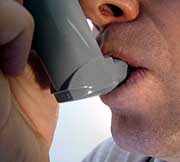 This newly-identified disease has symptoms identical to asthma, but is induced by exposure to chemicals. Symptoms include difficulty breathing, continuing cough, wheezing, and shortness of breath.
This newly-identified disease has symptoms identical to asthma, but is induced by exposure to chemicals. Symptoms include difficulty breathing, continuing cough, wheezing, and shortness of breath."Symptoms occur after only one exposure to a lung irritant. Many patients overcome the condition within six months, but others continue to be symptomatic for five years.
The following criteria are needed to confirm a RADS diagnosis:
- Documented absence of previous respiratory complaints.
- Onset of symptoms occurred after a single specific exposure to chemicals.
- Person was exposed to a gas, smoke, fume or vapor that was present in a high concentration and had irritant qualities.
- Onset of symptoms occurred within twenty-four hours after the exposure and persisted for at least three months.
- Symptoms simulated asthma, with cough, wheezing and dyspnea predominating.
- Testing shows airflow obstruction.
- Methacholine challenge testing was positive.
- Other type of pulmonary diseases were ruled out.
Injuries typically occur on-the-job, for example, hospital employees working in endoscopy units have recently been identified as suffering from RADS due to exposure to glutaraldehyde, widely considered one of the best disinfectants for cold sterilization. Glutaraldehyde was thought to pose little risk and it is normally used in unprotected, open environments. Reasearchers now report that methacholine challenge testing confirms a definite association between glutaraldehyde exposure and respiratory symptoms.
Other examples include firefighters exposed to irritants before and after the World Trade Center (WTC) disaster. The "World Trade Center Cough" is defined as a persistent cough that developed after exposure to the site. The cough is often accompanied by airway obstruction, nonspecific bronchial hyper-responsiveness, and clinical signs and symptoms of asthma.
Loosing the ability to enjoy clear breathing is a major, significant and life threatening injury. Juries now have the ability to legally hold accountable manufacturers and sellers who neglect to properly warn the public concerning the possibility that their could cause RADS/IIA.




